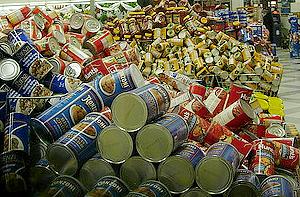 加拿大政府正在為禁止進口、販售與廣告含酚甲烷的PC嬰兒塑膠瓶一事徵詢公眾意見,日前有研究指出該類化學物質會從塑膠中滲出,干擾賀爾蒙分泌與神經功能,改變基因活動,危害人體健康。(酚甲烷英文名Bisphenol A,縮寫BPA,或譯作雙酚A。)
加拿大政府正在為禁止進口、販售與廣告含酚甲烷的PC嬰兒塑膠瓶一事徵詢公眾意見,日前有研究指出該類化學物質會從塑膠中滲出,干擾賀爾蒙分泌與神經功能,改變基因活動,危害人體健康。(酚甲烷英文名Bisphenol A,縮寫BPA,或譯作雙酚A。)
部分加拿大零售業者已經將該產品下架。衛生部長克萊門( Tony Clement )與環境部長貝爾德( John Baird )宣布將自4月26日起,舉行為期60天的討論,來徵詢多方意見。
衛生部長克萊門說:「根據我們首相在2006年12月8日公布的化學物質管理計畫,加拿大是世界上第一個對於部分化學物質實施風險評估的國家。」
加拿大對於酚甲烷的風險評估,主要是針對18個月以下的嬰兒,然而,也有人提出對所有人來進行風險評估的聲音。
研究指出,聚碳酸酯製成的嬰兒瓶(即PC塑膠瓶)在高溫下會釋放出酚甲烷,而這也是新生兒接觸該物質的主要管道。科學家表示,在這項風險評估研究中酚甲烷雖沒有超過會造成危害的臨界濃度,但是差距並不太大。
加國政府目前正跟業界合作研發食物包裝的替代材料,也研擬將酚甲烷列入加拿大環境保護法管理,頒佈相關標準作業流程。
加拿大科學家發現即使是低濃度的酚甲烷,長期暴露後也會對魚類及其他水中生物造成傷害,在污水處理廠中可以找到相關證據。
 加拿大綠黨的高層代表說,酚甲烷不只出現在嬰兒塑膠瓶與食物罐頭櫬裡,在兒童玩具、牙科材料、運動安全帽,CD唱片和其他硬式塑膠產品中也可以找到它的蹤跡。
加拿大綠黨的高層代表說,酚甲烷不只出現在嬰兒塑膠瓶與食物罐頭櫬裡,在兒童玩具、牙科材料、運動安全帽,CD唱片和其他硬式塑膠產品中也可以找到它的蹤跡。
綠黨主席梅(Elizabeth May)說壬基苯酚(nonylphenol)也應得到同等重視,該物質與酚甲烷一樣會干擾人體內分泌功能。壬基苯酚應用在塑膠、個人保健用品、乾洗與一些工業流程之中,在考量人體健康與水中生態後歐盟已經禁止使用。
The Canadian government is asking for public comment on whether or not to ban the import, sale and advertising of polycarbonate baby bottles than contain the chemical bisphenol A. The chemical has been shown to leach from some plastics, harming human health by disrupting normal hormone and neurological function and altering gene activity.
Some Canadian retailers have already pulled bottles made with the substance off store shelves. Health Minister Tony Clement and Environment Minister John Baird announced the action Friday and the 60 day public comment period began on Saturday.
"Canada has been the first country in the world to conduct risk assessments on a number of chemicals of concern, as a result of a new initiative announced by the Prime Minister on December 8, 2006 known as the Chemicals Management Plan," said Clement.
Health Canada's screening assessment of bisphenol A primarily focused on its impacts on newborns and infants up to 18 months of age; however, health risks for Canadians of all ages were considered in the screening.
It was determined that the main source of exposure for newborns and infants is through the use of polycarbonate baby bottles when they are exposed to high temperatures and the migration of bisphenol A from cans into infant formula.
The scientists concluded in this assessment that bisphenol A exposure to newborns and infants is below levels that may pose a risk, however, the gap between exposure and effect is not large enough.
The government proposes to work with industry to develop alternative food packaging and develop a code of practice and to list bisphenol A under Schedule 1 of the Canadian Environmental Protection Act.
Environment Canada scientists found that at low levels, bisphenol A can harm fish and aquatic organisms over time. Studies indicate that it can currently be found in wastewater and sludge treatment plants.
The top Canadian Green Party official says bisphenol A is found not only in polycarbonate plastic baby bottles and in the lining of canned foods and beverages but also in childrens?toys, baby bottles, dental sealants, sports helmets, compact discs and other materials made from hard plastics.
Green Party leader Elizabeth May said that nonylphenol, another hazardous substance with similar hormone-disrupting properties should be given the same attention as bisphenol A. Nonlyphenol can also be found in plastics, as well as personal care products, commercial and household cleaners and some manufacturing processes. Nonylphenol and its derivatives have already been banned in the European Union due to concerns over both human health and its effect on aquatic life after entering waterways
全文及圖片詳見:ENS


